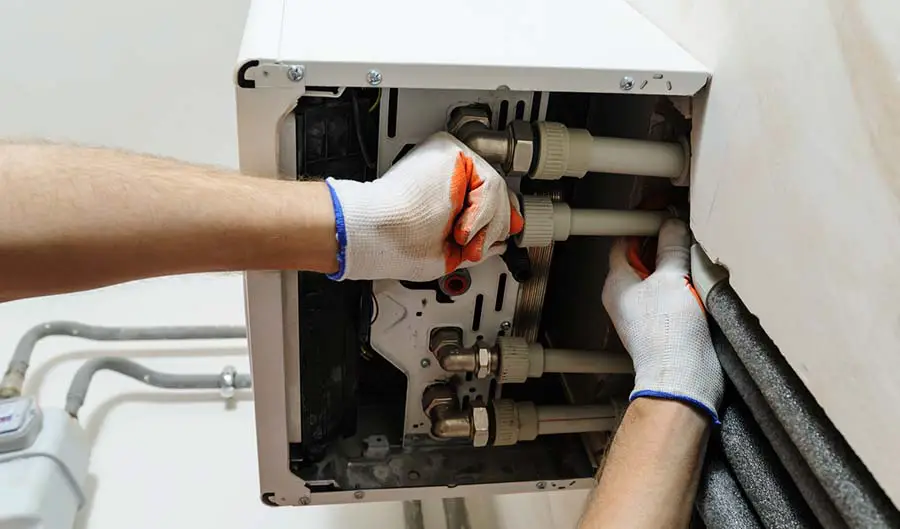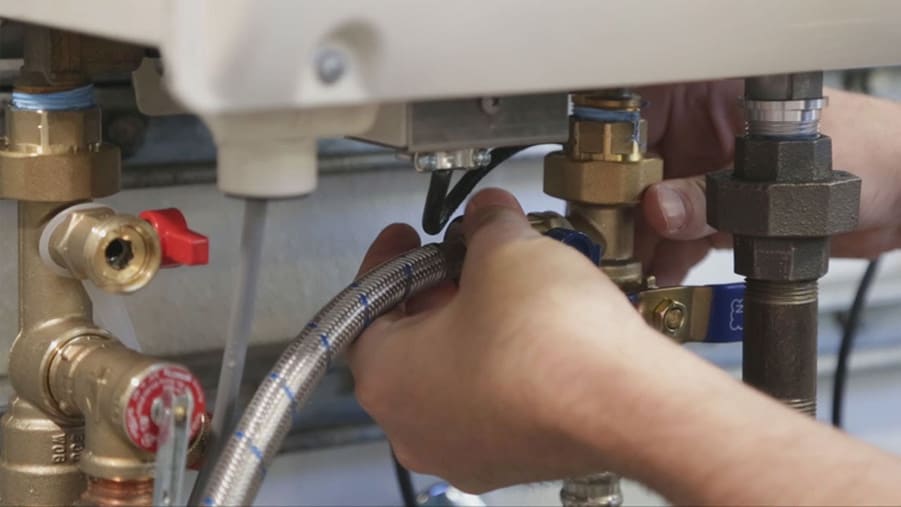
Tankless water heaters offer the discretion and space management that tank heaters do not. In addition, they have a longer lifespan and are significantly more energy-efficient when compared to their counterpart. However, being tankless does not mean they will not leak. Here are some of the reasons why tankless water heaters leak
Tankless water heaters primarily develop leaks is due to improper installation. Improperly installing a tankless water heater can lead to leaks caused by weak pipe connections, a poor venting system, or a too-high water flow. Leaks can also stem from blocked pipes or mineral buildup from hard water.
In this post, we will look at how tankless water heaters work, and then we’ll explore the most common reasons your unit might leak.
What Causes a Tankless Water Heater to Leak?
Consumers believe that tankless water heaters don’t leak. For most of us, since this type of heater does not come with a tank, the assumption is that it will not leak.
But simple logic suggests that, while a tankless water heater may not have a water reservoir, it produces hot water on demand making it still subject to leaks because water will run through it at some point.
The cold water from the main plumbing supply line will inflow into the unit with a high-power burner and pass through a heat exchanger. That is the mechanism that enables the unit to give instant hot water whenever needed.
Most professional plumbers will tell you that improper installation is one of the leading culprits of leaks within the first or second year of the product’s life cycle. Other reasons include:
- Bad water conditions (hard or acidic water)
- Improper venting
- High water flows
- Gas piping
- Water pipe connection
The good news is that the leak will only amount to around 1 GPM (gallon per minute) in a tankless heater. That means the damage caused to a property is far less than what you can expect with a tank heater.
However, it’s always a good idea to install a drain pan along with your tankless water heater. So that, in the unlikely event that it suffers a leakage, the drain pan will contain the water and prevent damage to property before your plumber arrests the leak issues.
Even though you hope that the water heater will never leak, installing a drain pan is a good precaution should there be leakage at any point in the lifecycle of the water heater.
It’s worth noting that when a tankless water heater has been installed correctly and is maintained regularly, it can serve you for its entire lifecycle without a leak.
We have already mentioned why a tankless water heater will leak. Let’s further explore those reasons to know how they happen and what can be done to avoid them.
1. Bad Water Conditions
Homes and commercial properties that have installed tankless water heaters need to be aware of the status or condition of the water that runs through their plumbing system. That is important because hard or acidic water is bound to impact your heater negatively if not corrected.
Hard water contains dissolved mineral sediments such as calcium and magnesium that will accumulate in the piping system over time.
How does hard water affect your tankless water heater?
Well, the mineral sediments will accrue, and some of them make their way into your tankless heater. They then impair the proper function of the heat exchanger by causing it to overheat.
The overheating will, in turn, result in having your heater send an error code to the control panel and then lockdown.
The build-up of mineral sediment is the same culprit that eats away at the pipes in your tank water heater unit, which eventually results in pinholes that grow larger with time, resulting in inevitable leaks.
Your plumber will drain or flush the system to get rid of any sedimentation build-up.
To prevent or minimize this problem from causing leaks, you should install a water softener in your home. Your plumber will be able to help you do that.
One of the symptoms of mineral build-up in the pipes and your tankless water heater is yellow or brown water coming out of your faucet every time you turn it on.
Installing a water softener solves this problem because softeners are designed to effectively eliminate calcium, magnesium, and other minerals from the water before it proceeds into your piping system and tankless water heater.
What Is Acidic Water?
Any water with a pH of 6.5 and below is said to be acidic. Remember that PH levels are measured on a scale of 1-14, with 7 being a neutral pH value. That also means that water with a pH value higher than 7.5 is likely to be alkaline or basic.
Acid water has corrosive properties and will wreak havoc on your pipes, including those in your tankless water heater. Over time, this will lead to pinholes in your piping and eventual leaks.
If you ever notice your water leaving blue-green stains in color on your bathtub, drains, faucets, and around your sink, you should automatically know that the culprit is acid water. That also means that your copper and aluminum pipes are eroding.
With acid water, the solution lies in installing a whole-house acid neutralizer. An acid neutralizer consists of calcite which is effective in raising the water PH. The acid neutralizer is installed at a point where it interacts with the water before the water enters your household plumbing system.
That should help effectively discourage pinholes and cracks from forming on pipes in the plumbing system of your household, including those in your tankless water heater.
2. Improper Unit Venting
Venting for your tankless water heater is done through the roof or wall. It is imperative that the venting be done as per the specification of the manufactures to ensure optimal performance.
Proper installation of the venting systems plays a key role in preventing condensations that may cause leaks into the tankless water heater. Condensation can potentially lead to system failure as the water interferes with the proper functioning of the unit.
3. Water Pipes Connections
Meticulous care should be observed when installing water pipes for a tankless water heater.
Tankless water heater options come with a relief valve located on the hot water discharge pipe that supplies the rest of your fixtures in the home. Make sure that the valve is well tightened.
Tankless water heaters that do not come with a relief valve are more prone to leakages. That’s because there is no relief on pipe jointing when the pressure builds up. Relief valves are also helpful for draining or flushing the tankless water heater.
To ensure that water leaks are prevented or reduced to a minimum, you want to ensure that the water heater has a relief valve. If it doesn’t, your plumber should be able to find you one that will install properly and is well sized to fit your unit.
4. Blocked Inlet and Outlet Pipes

Water is not the only leakage that can cause issues or a hazard in your tankless water heater.
This type of heater can draw power from several energy options such as electricity, natural gas, or propane. If natural gas or propane powers your unit, it will need to have an exhaust pipe connection that expunges poisonous gases due to combustion to the house’s exterior.
Gas-powered tankless heaters can experience dangerous gas leaks due to loosely connected pipes.
Also, the pipe may get blocked by a rodent or bird trapped in it from the exterior exhaust piping.
It is not uncommon for birds to build nests in the exhaust pipe and therefore effectively clog it.
Fortunately, natural gas or propane-powered tankless heaters will come with an integrated safety feature that alerts you of such irregularities by sending an error message to the control panel of your water heater.
That will prompt you to call a professional plumber to come and fix the issue. In case of any leaks in the gas pipes, the control panel will alert you so that you can take appropriate action promptly.
5. High Water Flow Rates
Tankless water heaters are designed to deliver optimal performance when working with low flow rates and low water pressure.
High flow and high water pressure can cause leaks in your water heater.
That means that if you live in a residential area, you want to make sure that the flow rate of your unit is roughly 19 GPM with a pressure that does not exceed 30 PSI.
As part of regular maintenance, users are encouraged to periodically remove and clean debris that might accumulate on the faucet aerators and showerhead. By so doing, you are preventing the heater from firing up unnecessarily as a result of debris.
Should My Tankless Water Heater Be Dripping?
If your tankless water heater is functioning correctly, it should not be dripping. The only exception is when there is a drip at the relief valve due to mounting pressure within your water heater. Any other drip or leak will be a result of one of the above reasons highlighted earlier.
While you don’t expect your tankless unit to leak, as we mentioned before, it is best to install a metal drain pan as a precaution in the event of a leak.
A suitable and high-quality drain pan can contain any leakages that might occur in the life cycle of the tankless water heater.
A drain pan also serves to direct any leaks safely away from your property. Therefore, it can help you save thousands of dollars in mold and mildew repair or any structural damage caused by leakages.
Can You Repair a Leaking Tankless Water Heater?
Following scheduled maintenance will mean any leakage issues can be caught well on time and addressed with repairs that are not costly. Most leakages are repairable, and your plumber will advise on the ones that are not.
A corroded pipe is replaceable while you can tighten loose valves and connectors.
Corrosion that causes leaks in the heat exchanger is often irreparable and will need for the heat exchanger to be replaced.
Preventative measures such as installing a water softener in your home in the case of hard water or neutralizing acidic water with the help of an effective acid neutralizer will go a long way towards minimizing the need for repairs.
What Is the Life Expectancy of a Tankless Water Heater?
With proper installation by an experienced professional, you can expect your heater to last from 12-20 years. That said, the life cycle of a tankless water heater depends on adhering to the recommended maintenance schedule set by the manufacturer.
Most tankless heaters also come with a warranty that’s usually half the life cycle of the purchased unit. To ensure the heater’s longevity, you want to honor the maintenance schedules and not do anything to invalidate your warranty.
This way, you can still enjoy the manufacturer’s support, including a component covered by warranty failure.
Conclusion
Tankless water heaters are ever-evolving and more efficient in energy conservation.
Their operation costs barely go up compared to water tank heaters, whose costs are constantly shooting up. Maintenance of a tankless water heater is much easier, and their extended lifespan makes them even more worth it.
These are all added advantages of having a tankless water heater. But most importantly, it is less likely to leak compared with its tank counterpart.
Overall, considering an upgrade to a tankless water heater option is a good idea when it is time to replace the old water heater.







